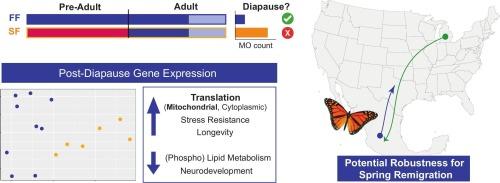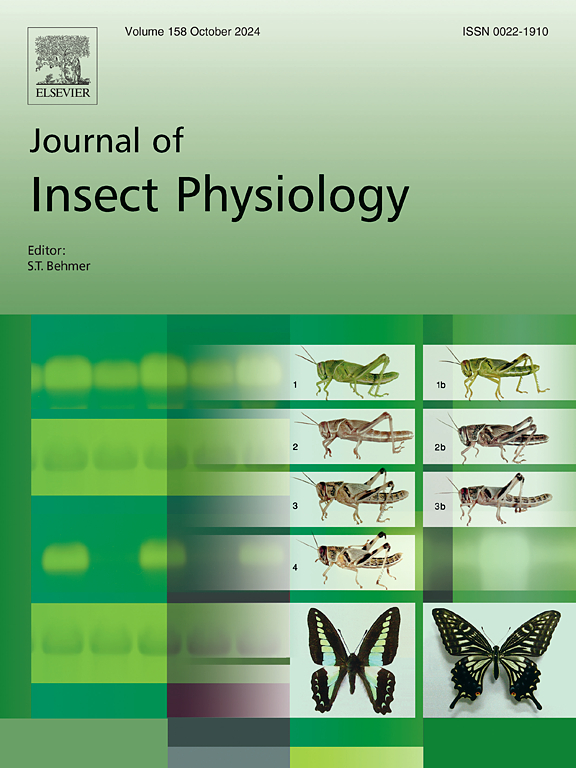滞育史对黑脉金斑蝶成虫脑基因表达有持久影响。
IF 2.3
2区 农林科学
Q1 ENTOMOLOGY
引用次数: 0
摘要
滞育是一种环境诱导的转录驱动的替代发育程序,使生物体能够承受不利的环境条件。一旦在允许的条件下恢复发育,滞育经历的持久后果尚未得到广泛探讨。帝王蝶提供了一个有趣的系统来解决这个问题,因为生殖滞育是它们每年北美迁徙的关键组成部分。滞育后的雌性帝王蝶在墨西哥的越冬地点交配后迁徙到美国南部,但与夏季非迁徙帝王蝶相比,它们表现出潜在的更强的健壮性(更大的繁殖能力和寿命)。本研究进一步探讨了滞育经历对帝王蝶的表型影响。在不同的成虫前条件下饲养的帝王蝶,无论是自然下降(滞育诱导)还是实验室夏季(非滞育发育),在羽化后转移到相同的自然下降条件下,然后在相同的控制条件下检测成虫脑转录。我们发现,在成虫发育前的自然落体条件是诱导滞育的必要条件。滞育史是成人大脑转录的一个强有力的预测指标。滞育后个体保留了滞育维持过程的特征,如改变的蛋白质产生、线粒体代谢和脂质调节。然而,滞育后的反应在转录上是不同的。与翻译相关的基因,尤其是与线粒体核糖体蛋白相关的基因,在滞育后表达增加,而与磷脂代谢和神经发育功能相关的基因在滞育后个体中表达减少。滞育后个体也表现出增强的应激反应和促进长寿的机制。总的来说,滞育历史对环境反应有持久的影响,可能影响帝王蝶的迁徙飞行。本文章由计算机程序翻译,如有差异,请以英文原文为准。

Diapause history has lasting effects on adult brain gene expression in monarch butterflies
Diapause is an environmentally induced, transcriptionally driven alternative developmental program that enables organisms to withstand adverse environmental conditions. The lasting consequences of diapause experience once development is resumed in permissible conditions have not been extensively explored. The monarch butterfly provides an interesting system to address this question as reproductive diapause is a critical component of their annual North American migration. Post-diapause female monarchs remigrate to the southern US after mating at overwintering sites in Mexico yet show evidence of potentially increased robustness (greater reproductive capacity and longevity) compared to summer non-migratory monarchs. Here we further investigate the phenotypic effects of diapause experience on monarch butterflies. Monarchs reared under different pre-adult conditions, either natural fall (diapause inducing) or laboratory summer-like (non-diapause development), were shifted to identical natural fall conditions upon eclosion and then assayed for adult brain transcription under identical controlled conditions. We find that fall conditions during pre-adult development are necessary to induce diapause. Diapause history is a strong predictor of adult brain transcription. Post-diapause individuals retained signatures of diapause maintenance-like processes, such as altered protein production, mitochondrial metabolism, and lipid regulation. However, the post-diapause response is transcriptionally distinct. Genes related to translation, with particular emphasis on mitochondrial ribosomal proteins, have increased expression post-diapause, while genes enriched for phospholipid metabolism and neurodevelopmental function have decreased expression in post-diapause individuals. Post-diapause individuals also show evidence of enhanced stress response and mechanisms that promote longevity. Overall, diapause history has lasting consequences on environmental response that may impact monarchs’ remigratory flights.
求助全文
通过发布文献求助,成功后即可免费获取论文全文。
去求助
来源期刊

Journal of insect physiology
生物-昆虫学
CiteScore
4.50
自引率
4.50%
发文量
77
审稿时长
57 days
期刊介绍:
All aspects of insect physiology are published in this journal which will also accept papers on the physiology of other arthropods, if the referees consider the work to be of general interest. The coverage includes endocrinology (in relation to moulting, reproduction and metabolism), pheromones, neurobiology (cellular, integrative and developmental), physiological pharmacology, nutrition (food selection, digestion and absorption), homeostasis, excretion, reproduction and behaviour. Papers covering functional genomics and molecular approaches to physiological problems will also be included. Communications on structure and applied entomology can be published if the subject matter has an explicit bearing on the physiology of arthropods. Review articles and novel method papers are also welcomed.
 求助内容:
求助内容: 应助结果提醒方式:
应助结果提醒方式:


